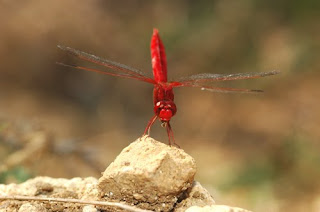I got this set of pictures four years ago during a weekend in Gozo with my family. We were visiting a small freshwater pool at Dwejra. My intention was to take some photos of damselflies and dragonflies but as happens often in nature photography I ended up taking pictures of something totally unexpected.
I saw this beautiful male lizard sunning himself on top of a boulder. It looked tame and I moved close to it to get some pictures. Lizards on Gozo are tamer than those on Malta and I managed to get some beautiful closeups.
Half way through the photo session he was distracted by a female lizard that was passing by in the vicinity. He looked only once (it must have been love at first sight) and he left his boulder to follow her.
When he reached her he placed himself in front of her and started to show off his bright yellow throat. She must have been impressed by his display because she slowed down her pace.
When she passed by he ran after her and caught the tip of her tail in his mouth. She seemed to be ignoring him and continued walking. Sometimes he held placed his front leg on her tail to slow her down.
He then moved his mouth, one small bite at a time, towards the front part of the tail and beyond and continued until he was holding her from the abdomen.
While this was going on he was oblivious to the fact that I was taking pictures and three other people including two noisy young girls were watching him closely.
He then entwined himself around the female and twisted himself so that their genital organs were touching. He remained in this position for several seconds. When they were ready she continued walking in the original direction and he went back to his boulder.
The whole photo session took about five minutes but the actual courtship and copulation lasted less than a minute.
I had never seen this behaviour before and I have not seen it since even though I spend many hours every week in the countryside. One might call it luck but if you spend enough time out in nature you are bound to meet interesting situations.













